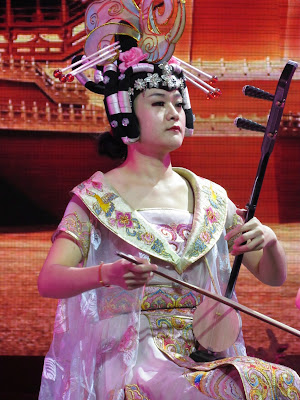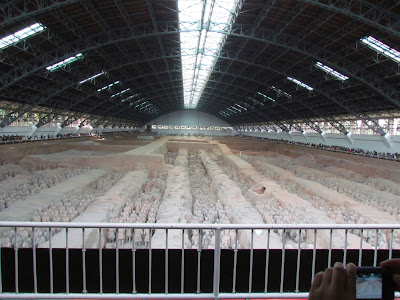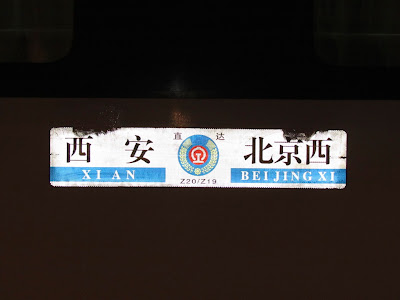CHINA - XIAN
An early start to get out to the airport to catch our flight to Beijing, the same excellent service from Singapore Airlines on a six hour flight. The airport at Beijing was built to support the Olympic Games in 2008 and a splendid affair it is. The terminal is in the centre of the airport and, after passing through immigration, you get on a little driverless train that takes you out to the perimeter. It was immediately obvious that China has a large population if the crowds were anything to go by. However, the airport runs smoothly and we soon had our bags and had a very short wait for a taxi got to the City centre. None of the drivers speak any English but we had our destination written down in Chinese, an idea gleaned from pre-travel research. The road system has to handle very large traffic flows and we expected
traffic jams but for all our time there the traffic was never a real
problem. One thing however, they drive quickly and weave across the
lanes at will. And yet we only saw one accident during our time in
China when a car hit a bus.
We dropped our main suitcase off at the Swissotel Beijing where were going to stay while in Beijing but on this occasion we were moving on to the city of Xian, famed as the home of the terracotta soldiers.
We had booked our tickets a long time before and eventually an email arrived with instructions to collect our tickets at the station. We had read how to do this and did find a ticket wicket with an English speaking booking clerk and with tickets in hand we joined the crowds through security into the station proper. The system they use asks you to go to your own waiting room. There are many such waiting rooms and you look to see which one handles your train. There was enough English around to tell us the number of the waiting room which was more than full. Each waiting room handles about an hours worth of departures. Rail travel is very popular and it was also the time of the annual general weeks holiday which probably made it extra busy. Eventually your train is called and masses of people crowd to the exit, you get used to being pushed and eventually realize you need to push too.
Our train was an overnight sleeping car train non-stop to Xian, a journey of just over 11 hours There were three classes, hard, soft and deluxe soft. Hard has six berths in each compartment, soft has four and deluxe soft has two. We had tried to get deluxe soft but we given soft, which meant we were going to meet two strangers. They turned out
to be a teenager who had some English and an older lady who had none.
We got on well. The compartment was very clean and well equipped with
sheets and duvets. We had read that the only weak link was the food
served on the train so we had brought our food with us. The old lady
slurped her noodles in noisy fashion. Each carriage has a young
attendant. If you have ever read "Riding the Iron Rooster" by Paul
Theroux, it has all changed and you couldn't fault the system, other
than the toilets which were squat at end of the carriage and western the
other. Not too exciting. Toilets in China often leave a lot to be
desired.
You can see a larger version of any
photograph by simply clicking the mouse once on the image. Another click
outside the image returns you to the text
Our two berths
Our friendly travelling companions
A water garden
This little fellow was there to keep people from standing on a low wall, very aggressive and who enjoyed his whistle
It was an excellent show, always changing
There were many merchants stalls nearby and this looked a bit like "What the butler saw". We weren't sure what they were looking at.
We had arranged for a personal guide for the two days that we were to be in Xian. We left the station amongst a large throng and our guide was waiting for us holding up a sign. A good job because there were so many people around. Jane Yang was going to look after us with her driver who had name that sounded like Mister Meow, he had no English but Jane was very proficient. We had read good reviews of her and she was excellent.
Xian is the capital of the Shaanxi province, and is one of the oldest cities in China with more than 3,100 years of history and it at the Eastern end of the Silk Road. Jane had planned a busy two days for us and after breakfast we visited the Shaanxi History Museum. This is a very large museum and a major tourist attraction. It was very crowded, you get used to the jostling crowds. It is quite dark inside and photography was not that easy although there were plenty of cell phones at work. It was information overload but we did get a perspective into the various dynasties. There was a large emphasis on the Terracotta Army which were going the visit the next day.
Inside the Shaanxi History Museum
Our next port of call was the Giant Wild Goose Pagoda, a Buddhist pagoda
located in southern Xian. It was built in 652 during the Tang Dynasty
and originally had five stories, although the structure was rebuilt in
704 and its exterior brick facade was renovated during the Ming Dynasty
(1368–1644) .
The Wild Goose Pagoda
Must be something worth seeing
A water garden
This little fellow was there to keep people from standing on a low wall, very aggressive and who enjoyed his whistle
It was an excellent show, always changing
There were many merchants stalls nearby and this looked a bit like "What the butler saw". We weren't sure what they were looking at.
He was a pretty loud individual
Jane took us to a restaurant for a nice lunch. That was one advantage of having a guide because choosing where to eat is a challenge when there is little English to read.
After lunch we drove to the City Wall. The wall stands 12 meters tall, 12-14 meters wide at the top and 15-18 meters thick at the bottom.
It covers 13.7 kilometers in length with a deep moat
surrounding it. Every 120 meters, there is a rampart which extends out
from the main wall. All together, there are 98 ramparts on the wall,
which were built to defend against the enemy climbing up the wall, not that that would have been easy. We walked on it for a short way together with the usual crowd of people.
Strolling on the wall
One of the large gatehouses
One way to get around, bicycles and tandems were very popular
Looking through the wall to the moat
A not a very looking friendly cart
We took off again to the Muslim Quarter which was near our hotel. Jane kept us busy.
As the starting point of the famous Silk Road, Xian attracted traders
from West since 1st century BC. During the 8th century AD, Xian was the
largest city in the world with over one million inhabitants, among
which one third of them were foreigners. The ancestors of these Muslims
dwelled in Xian with local Han people harmoniously and built the Great Mosque for
worship simultaneously.
Muslim quarter is a fascinating area where you can find exotic food,
interesting people (some of the residents still look like their
Arabian cousins) and great souvenir stalls. You can taste many authentic
Islamic snacks. We weren't that brave to try anything as street food can be hazardous to your health we were advised. That didn't seem to stop anyone in the as usual large crowds.
These are quail eggs, very tiny
Not sure
Nuts, nuts and nuts
Another mystery meal, looks like potatoes, peppers and onions
Kebabs and other meats ready to cook
We returned to the hotel for a break but our day wasn't over. We were collected by Mister Meow who took us to the Dynasty Dinner Show at the Shannxi Opera House. This starts with a Dumpling Dinner and is followed by Tang Dynasty Show.
This is one of the favourite places on any tourist's itinerary. The dumplings are a little like Dim Sum but contain many different things wrapped in pastry rather than rice. You get a drink to go with the meal and dessert items. Jane knew it was Robin's birthday and when Happy Birthday was sung to anyone with a birthday a birthday cake of sorts arrived at the table. Quite an experience, at least for one time.
Our table companions were from Sydney, Australia
After the dinner came the show, colourful and accompanied by not unpleasant Chinese music. The show was accompanied by English and Chinese text show on screens. The English was very good apart from a few howlers.
He looked a bit stern
This was very melodic - the Pipa
This was less so. The instrument was the Chinese violin, the Erhu
The corps de ballet
This fellow had the most amazing lung power and endurance playing the Suona. He brought the house down
Quiet elegance
It was a very good evening after an excellent day. Mister Meow was waiting for us to get us home.
Up
early the next day to meet up with Jane and Mister Meow and this was the
day we went out to see the Terracotta Army, probably one of the world's great tourist attractions. To judge by the crowds it certainly is. We had the usual traffic weaving ride to the East of Xian.
The Terracotta Army or the "Terracotta Warriors and Horses", is a collection of terracotta sculptures depicting the armies of Qin Shi Huang, the first Emperor of China. It is a form of Funerary art buried with the emperor in 210–209 BC and whose purpose was to protect the emperor in his afterlife. The Terracotta Army was listed as a UNESCO World Heritage Site in 1987.
The figures were discovered in 1974 by some local farmers by accident. The figures vary in height according to their roles, with the tallest being the generals. The figures include warriors, chariots and horses. Current estimates are that in the three pits containing the Terracotta Army there were over 8,000 soldiers, 130 chariots with 520 horses and 150 cavalry horses, the majority of which are still buried in the pits near by Qin Shi Huang's mausoleum.
The terracotta army figures were manufactured in workshops by government laborers and by local craftsmen. The head, arms, legs and torsos were created separately and then assembled. Studies show that eight face moulds were most likely used, and then clay was added to provide individual facial features. Once assembled, intricate features such as facial expressions were added. No two faces are alike. It is believed that their legs were made in much the same way that terracotta drain pipes were manufactured at the time. This would make it an assembly line production, with specific parts manufactured and assembled after being fired as opposed to crafting one solid piece and subsequently firing it. Upon completion, the terracotta figures were placed in the pits in precise military formation according to rank and duty.
The army can be seen in three pits. The largest and most impressive is Pit No 1 and that was where we started our visit.
Overview of Pit No 1
The location of the topknot determines whether the figure was a soldier and archer of a horseman
This was the condition of the warriors as they we uncovered
Probably the most photographed view
Looks like he is wearing a Dairy Queen portion
These are waiting to be placed into the pit after reconstruction
Some of the horses
These were in Pit No 3, which is the smallest of the three
The heads were most common missing part
More horses in Pit No 3
In the Pit No 3 museum. The colour disappeared when the army was exposed to air.
A fine figure of a man
Overview of Pit No 2
Jane and a real live soldier
The main museum
Half size models of some horses who are pulling a carriage
Just a few of the crowds
A pomegranate seller. There were many many such sellers on the road from Xian.
Our other visit was to the Banpo Neolithic Village Museum in Xian. The Banpo Site is a typical Neolithic matriarchal community of the
Yangshao Culture dating back about 6,000 years. At that time, the Banpo
people used tools made primarily of wood and stone. Women, the crucial
labor force, were responsible for making pottery, spinning, and raising
the family, while men fished.
The site was discovered
accidentally in 1953 and now covers an area of 50,000 square meters. The
village was divided into three main sections: the living section, the
pottery-making section, and the burial section. Archaeologists have
found about 10,000 production tools and utensils, 46 houses, 2 pigsties,
200 cellars, 6 pottery kilns, 174 adult burial pits and 73 burial jars
for the children. Many artifacts and finds were unprecedented and depict
the daily lives and local production of these people some 6,000 years
ago.
Reconstructed huts in the village
Bonsai trees
At the Banpo Village
Taking our leave of Mister Meow near the station
Our tour was over and we took leave of Jane and the driver. We had to get our return tickets and this time there was no English speaking booking clerk. By a lot of pointing to numbers on the voucher we got our tickets, passed through security and found our waiting room, crowded as usual. For this journey back to Beijing we did have deluxe sleeper berths so we had the luxury of our own western style toilet and sink and no travelling companions. The train lady offered us tea of coffee before arrival in Beijing.
At least we were in the correct waiting room
The signal get onto the platform. The trains leave on dead on time in China
Yes, its the right one
The bathroom
Upper and lower berths, a table water jug and a flower
On the dot the train left for the return eleven hour journey to Beijing.




























































No comments:
Post a Comment